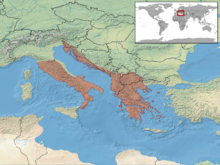Elaphe quatuorlineata
| Elaphe quatuorlineata | |
|---|---|
 | |
| Conservation status | |
| Scientific classification | |
| Kingdom: | Animalia |
| Phylum: | Chordata |
| Subphylum: | Vertebrata |
| Class: | Reptilia |
| Order: | Squamata |
| Suborder: | Serpentes |
| Family: | Colubridae |
| Subfamily: | Colubrinae |
| Genus: | Elaphe |
| Species: | E. quatuorlineata |
| Binomial name | |
| Elaphe quatuorlineata (Lacépède, 1789) | |
 | |
| Synonyms | |
| |
Elaphe quatuorlineata or the four-lined snake (Croatian: kravosas) is Europe's largest nonvenomous colubrid species.
Geographic range
It can be found in southern Europe, mostly in Italy and the Balkans from Slovenia to Greece.
Description
Adults are yellowish brown with four dark stripes, to which the specific name refers.[2] There is a dark streak from the eye diagonally to the corner of the mouth. Juveniles have a dorsal series of dark brown blotches with alternating dark brown spots on the sides, all on a pale brown background.[3] Adults are up to 260 cm, and sometimes longer. Back scales are lightly but distinctively keeled. In most populations, two preocular scales are present.[4]
See also
References
- ↑ Boulenger, G.A. 1894. Catalogue of the Snakes in the British Museum (Natural History), Volume II.., Containing the Conclusion of the Colubridæ Aglyphæ. Trustees of the British Museum (Natural History). (Taylor and Francis, Printers.) London. xi + 382 pp. + Plates I.- XX. (Coluber quatuorlineatus, pp. 45-47.)
- ↑ Bruno,S. and S. Maugeri. 1977. Rettili d'Italia, Tartarughe, Sauri e Serpenti. Giunti - Martello. Firenze.
- ↑ Schröder, Heinz. 1973. Lurche und Kriechtiere in Farben. Otto Maier Verlag. Ravensburg.
- ↑ Arnold, E.N., and J.A. Burton. 1978. A Field Guide to the Reptiles and Amphibians of Britain and Europe. William Collins Sons & Co. Ltd., Glasgow. 272 pp. (Elaphe quatuorlineata, pp. 198-199 + Plate 36 + Map 111.)
Further reading
- Lacépède, B.G. 1789. Histoire Naturelle des Quadrupèdes Ovipares et des Serpens. Vol. 2. Impremerie du Roi, Hôtel de Thou. Paris. 671 pp. (Coluber quatuorlineatus, pp. 82, 163, Plate VII., Figure 1.)
